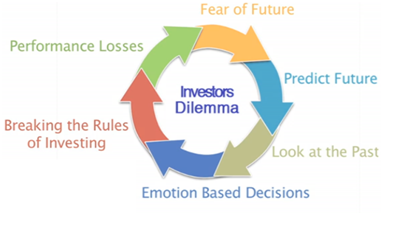Probability is the analysis of random phenomena that teaches us it is not possible to predict the outcome of discrete events, such as the chance that a stock will either increase or decrease in price.
According to the law of probability, a fund has a 50% chance of increasing in any year and a 50% chance of decreasing over the same time period. The fact that it increases one year does not change the fact that the following year it still has a 50:50 chance of increasing or decreasing.
That’s why it is inappropriate to rely on past performance when evaluating a mutual fund for investment. Brokerages may have hundreds or thousands of mutual funds that contain different mixes of the asset classes. By random chance, some will do well while others will not. What these funds advertise, but don’t explain, is that one of their funds achieved the “past performance” results that they promote. They don’t mention that all its other funds fell short of that level of performance. When you’re looking at past performance, remember that you’re only seeing part of the picture.
This is like misinterpreting the sign posted in casinos that reads something like, “We Pay Back 92% of Your Money!” (The exclamation mark is intended to make you believe that this is a good thing.) And 92% out of 100 is good – until you realize that it means that, on average, the best a gambler can hope to do is lose only 8% of his money. (Some people will win more than this average and some people will lose more.) Expecting a fund to achieve the same performance as it did the previous year is just gambling with your investment.
Mutual funds, retail brokers and financial advisors aggressively market funds awarded four and five stars by Morningstar, the Chicago-based arbiter of investment performance. But the rating system merely identifies funds that performed well in the past; it provides no help in finding future winners. The search for top-performing stock funds is an exercise that will come to be viewed as one of the great financial follies of the late 20th century.
Here’s an example of performance-based marketing. In the November 2000 issue of Money magazine, there was an ad headlined: “Tech stocks still hot. It touted a number one ranking and five stars. In 1998, the fund returned 196%, and 216% in 1999! Pretty impressive, right? But if you added this fund to your portfolio in 1999 or 2000, you would have noticed that it returned a dismal -51% in 2000. I’m quite sure there were no similar ads for the fund in 2001.
As the chart below illustrates, the reality is that even the top funds rarely exhibit the same performance for even two consecutive years.

From 2002–2012, on average only 7% of the top 100 fund managers repeated their performance the following year. In the years 2008 and 2009, no fund managers repeated their previous year’s top 100 performance.
A Wall Street Journal and Morningstar study found that 72% of consumers invested their money in four- and five-star-rated mutual funds that showed the highest returns during the previous three–five years. Funds focus on “past performance” for one simple reason: because it works in attracting new investment.



